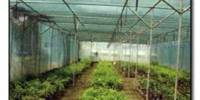Maxwell Ochoo’s initial foray into farming was a colossal flop. “Getting a job is a difficulty” in Ochieng Odiere, a village near the beaches of Kenya’s Lake Victoria says the 34-year-old. He turned to farm to make some money and feed his family. He planted watermelon seeds on his 0.7-hectare area in 2017.
A two-month dry spell occurred just as the melons were about to burst from their buds and swell into luscious orbs, and Ochoo’s young watermelons shriveled. He lost approximately 70,000 Kenyan shillings, or approximately $650.
Ochoo blamed the region’s loss of tree cover for the increasingly prevalent extended dry spells. He claims that the earth cooked since it was unprotected from the sun. Ochoo and a few neighbors decided to plant trees on public areas and small farms in 2018. The community planted hundreds of trees with the assistance of charitable organizations, turning some of the bleak slopes green. Ochoo now uses alley cropping on his own property, planting millet, onions, sweet potatoes, and cassava between rows of fruit and other trees.
The trees provide shade and cover for the crops and their deeper root systems aid in soil moisture retention. During the growing season, Ochoo takes papayas as big as his head to market a few times a week, bringing home the equivalent of roughly $25 each time.
And the fresh Calliandra trees’ fallen leaves supply food for Ochoo’s five cows. He also discovered that the fernlike leaves could be ground up and used as a dietary supplement for the tilapia he raises in a small pond. He now spends less money on fish food, and his tilapia develop significantly faster than his neighbors’.
Food production takes up roughly half of all habitable land on the planet. More than 30% of the world’s forests have been removed, and another 20% have been degraded, primarily to make place for livestock and food production.
Maxwell Ochoo
Almost everything Ochoo’s family eats now comes from the farm, and there’s plenty left over to sell at market. “Whether it’s a dry stretch or a wet season,” he explains, “my land is not bare; there’s something that can maintain the family.”
Many specialists believe that Ochoo’s tree-filled land depicts farming’s future. The current situation, in which fields are frequently cleared of trees to raise cattle or plant row after row of single crops known as monocultures, is running out of space.
Food production takes up roughly half of all habitable land on the planet. More than 30% of the world’s forests have been removed, and another 20% have been degraded, primarily to make place for livestock and food production. Researchers estimate that croplands will need to increase by 26 percent by 2050 to feed a burgeoning population, an area the size of India.
Farmers like Ochoo, who actively combine crops, trees, and cattle in a process known colloquially as agroforestry, provide a more sustainable path forward. Agroforestry may not work in every situation, but it offers “huge potential” for achieving both food production and conservation goals on the same area, according to Plieninger.
Integrating trees onto farms may seem like a recipe for lower yields, as trees would replace some crops. But such mixing can actually squeeze more food from a given plot of land than when plants are grown separately, Plieninger says. In Europe, blended farms that grow wheat or sunflowers between rows of wild cherry and walnut trees, for example, can produce up to 40 percent more than monocultures of the same crops for a given area.

Made in the shade
If you’re reading this while sipping a cup of coffee in the morning, the beans in your brew may have come from an agroforestry farm.
According to Eduardo Somarriba, an agroecologist at the Tropical Agricultural Research and Higher Education Center in Cartago, Costa Rica, coffee plants developed in the understory of Ethiopia’s highland forests and are well-suited to shade.
Coffee plants can grow under a diversified canopy of natural trees. According to Somarriba, certain trees pump nitrogen into the soil, eliminating the need for rigorous fertilizer treatment. Native vegetation inhibits weed growth, stabilizes soil and temperature, enhances water retention, and provides habitat for pollinators.
However, as the world’s appetite for coffee has risen, planting practices have changed toward shadeless plots containing just coffee plants that require a regular supply of artificial fertilizers. According to a study published in BioScience in 2014, the global share of coffee cultivated under a canopy of varied trees declined from 43 percent to 24 percent between 1996 and 2010.
Though the data is conflicting, removing trees is thought to be beneficial for enhancing yields. This concentration on statistics overlooks the more widespread benefits of diversifying farms, according to Somarriba, particularly small farms, which still produce the majority of the world’s coffee.
“If coffee prices fall and remain low for five or six years, a small farmer will not be able to make a living only from [selling] coffee,” adds Somarriba. Adding a variety of trees, on the other hand, can increase economic and climate resilience, he claims.
When coffee income are insufficient, valuable timber trees, such as mahogany, might be harvested as savings accounts. Mango, Brazil nut, and acai trees can also provide revenue. However, not all areas have well-developed markets for these items, according to Somarriba, posing a hurdle to growing the amount of coffee grown under shade.
Some conservationists are attempting to increase consumer demand for shade-grown coffee by emphasizing the advantages to biodiversity. The Smithsonian Migratory Bird Center, for example, bestows a Bird-Friendly accreditation on plantations that have plenty of native tree cover and diversity, which is beneficial to migratory birds. Certified growers can charge a little higher price, typically 5 to 15 cents per pound.
Migratory birds congregate in such plantations. “It seems like you’re in the forest when you’re in a bird-friendly coffee farm,” says Ruth Bennett, an ecologist at the Smithsonian Migratory Bird Center in Washington, D.C. “There are a lot of bird cries, and there is a vast diversity of birds, including incredibly sexy tropical species like the turquoise-browed motmot,” she explains.
Bird-friendly coffee plantations appear to be beneficial to mammals as well. According to a 2016 study published in PLOS ONE, Bird Friendly coffee plantations in Mexico had more local species, such as deer and mice, than other coffee plantations. Bennett claims that shade-grown coffee tastes better than conventional coffee. Coffee cherries mature more slowly in the shade, which increases their sugar content.
Time to recover
In Tanzania’s Shinyanga region, a return to traditional Indigenous methods, combined with modern agroforestry, has helped transform what was once the “desert of Tanzania” into fertile savanna woods.
The Sukuma people dwell in the region, which is about a five-hour drive southeast of the Serengeti. They were formerly agropastoralists who grazed livestock in the region’s steep grasslands, which are interspersed with acacia and oaklike miombo trees.
However, the landscape began to shift in the 1920s. The British colonial authorities hacked down forests in an ill-advised attempt to control tsetse flies, which were causing harm to cattle and humans, and to sow cash crops such as cotton. When the government took over many homesteads in the 1960s, forest loss accelerated. Local Tanzanians had less incentive to conserve the trees after they lost the right to harvest forest products.
The ecology had degenerated into dry, dusty stretches bereft of trees within a few decades. According to Lalisa Duguma, a sustainability scientist at World Agroforestry, an international research institution headquartered in Nairobi, Kenya, food, firewood, and water were short, and local livelihoods suffered.
















